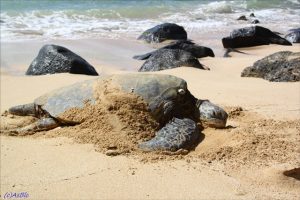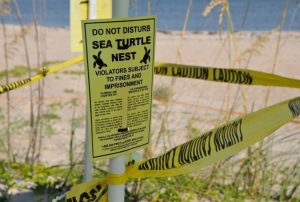Have you known that our beaches around Venice offer the great opportunity to watch one of the most impressive natural wonders of coastal life? From May 1 until October 31 is nesting season for the sea turtle!
Nesting
You will find nests laid by the loggerhead sea turtle – the most common in Florida -, green sea turtle, and some of the rare Kemp’s ridley turtle. All of them are endangered species and protected under federal law. The beaches of Manasota Key are the most densely nested beaches of all the Gulf of Mexico states.
Most females return faithfully to the same beach each time they are ready to nest. Not only do they appear on the same beach, they often emerge within a few hundred yards of where they last nested.
Only the females nest, and it occurs most often at night. The female crawls out of the ocean, pausing frequently as if carefully scoping out her spot. Sometimes she will crawl out of the ocean, but for unknown reasons decide not to nest. This is a “false crawl,” and it can happen naturally or be caused by artificial lighting or the presence of people on the beach.
Each nest bears about 80-120 eggs, depending on the species. After laying the eggs, the mother covers the nest entirely with sand. About 60 days later the hatchlings break open their shells and dig out of the nest. This is mostly done at night and at cooler temperatures. They instinctively crawl to the bright horizon, dash into the sea and swim offshore until the reach the currents that carry them away.
There are a lot of obstacles to pass: the hot sun that let them die from dehydration, predators on the land and in the sea, or the rising pollution with plastic. Only 1 in 1000 hatchling sea turtles will reach adulthood.
Tips
So please be very careful when making a beach stroll at night or in the early morning hours. Here are some useful tips to make their nesting season safer:
1. Be sure to keep some distance and be quiet when spotting a nesting turtle, a nest or hatchlings
2. Avoid any outdoor lighting as artificial light may lead to disorientation of the nesting females
3. If you spot a nest, remove any debris from the path of the nest to the ocean
4. Sea turtles and other marine life often die of digesting or get stuck in trash, so please do not litter.
5. On a lot of beaches animal friends have marked the nests with yellow or orange flags and meet early in the morning to help hatchlings on their way to the ocean. If you are interested to learn more about the life of the sea turtles or would love to join a turtle walk, you may contact one of the animal friend groups of the area, i.g. the Coastal Wildlife Club in Englewood, the Sea Turtle Conservation & Research at Mote in Sarasota or the Florida Fish&Wildlife Commission.



